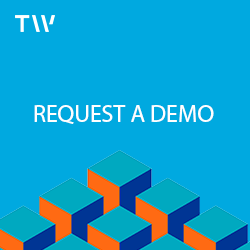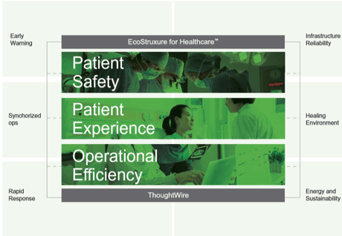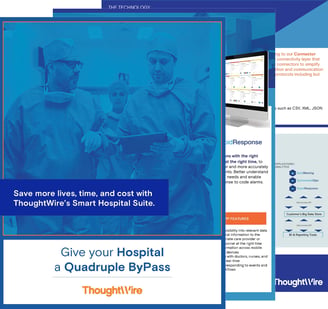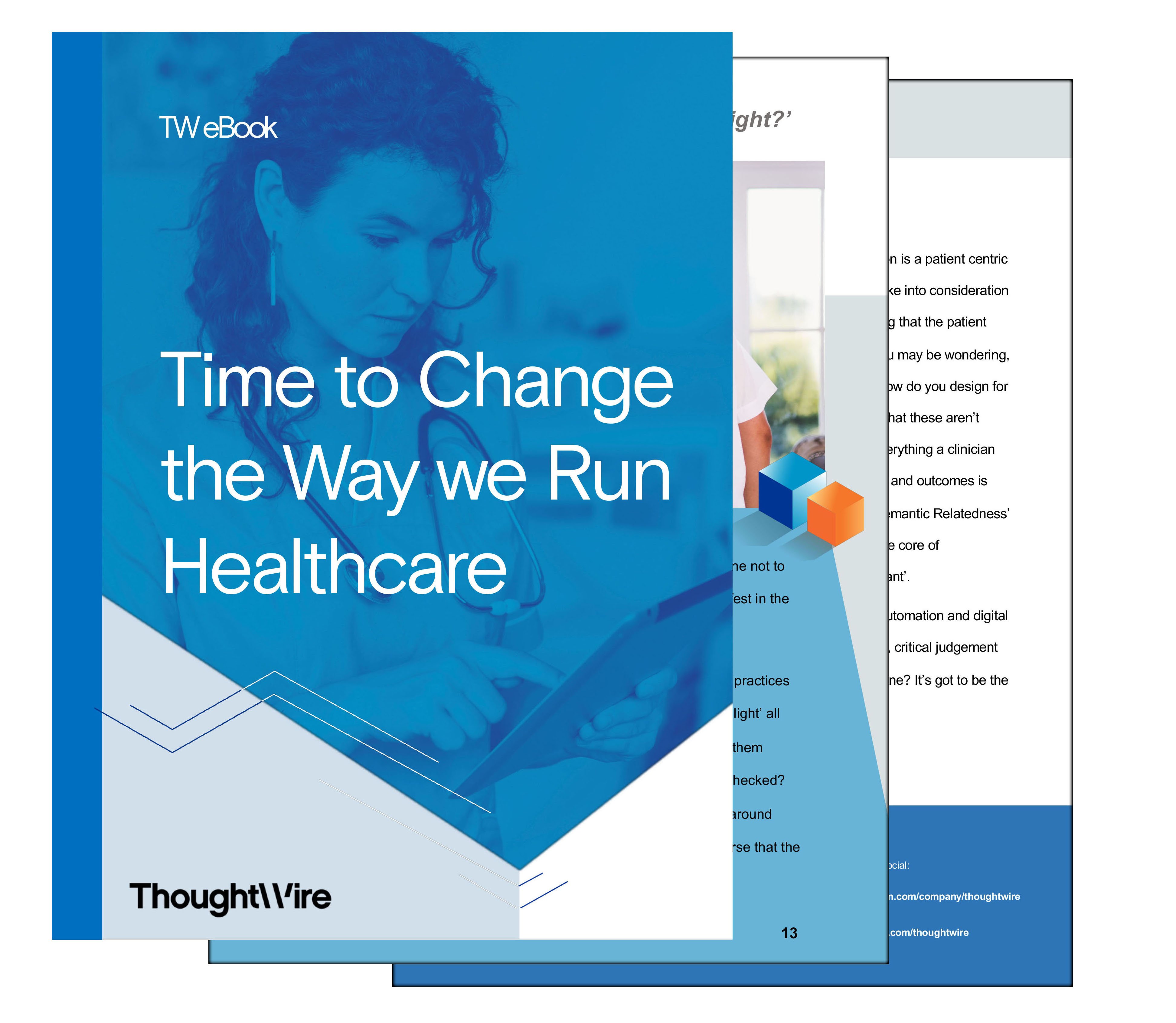Health systems have evolved significantly with technology throughout the years, with each innovation aiming to reach a higher level of transformation, efficiency, and interoperability than the last. Nowadays, we are seeing a shift toward Real-Time Health Systems (RTHS), in which relevant data is being shared in real-time between devices, people, and workflows.
These systems are shaping the new era of health care by driving better outcomes for patients, care teams, hospital administrators, and facility staff. But how does a hospital enable a real-time health system? And how do these new technologies differ from earlier hospital technology? In this blog, we explore the evolution of the real-time health system that has led to the use of Digital Twin technology today.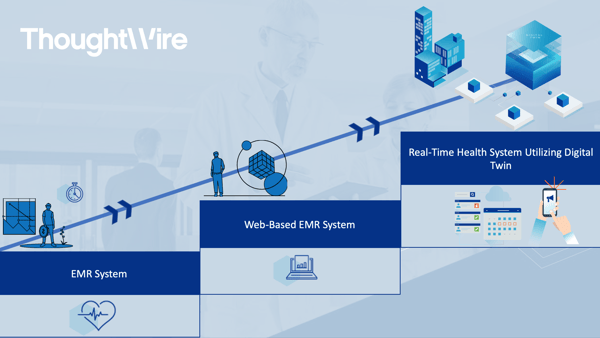
Traditional Server-Based EMR systems
New computer technology such as desktop computers to enter, and local servers to store data laid the foundation for the first Electronic Medical Records (EMR) system, developed in the early 1970s. EMR technology was one of the essential starting points for the future development of RTHS’s within the healthcare industry. EMRs emerged as a solution to eliminate the errors and inefficiencies resulting from paper charting. The traditional EMR system is a digital version of a patient’s charts. Patient data is stored on an internal server, containing patient medical history, diagnoses, medications, consults, orders, laboratory test results, and more. Although patient information is consolidated in a central location, there is still a delay in accessing and retrieving relevant patient information creating a new set of problems. For example, a clinician must log into the system, search for the right patient, and navigate through a myriad of screens before locating the relevant information.
An advantage to paper documents, traditional EMR systems strive to provide standardized patient records across hospitals to eliminate inconsistencies in information. The goal of an EMR is to enable faster and easier access to more accurate patient information for clinicians. However, traditional server-based EMRs lack complete and seamless interoperability with other hospital systems. The advantage of consolidated patient data exists, but traditional EMR’s still fall short in the need for immediate access to patient data when it is required for clinical workflows across facilities. With this older technology, the data from disparate health systems remains disconnected, leaving little room for healthcare staff collaboration and better patient care. Another example, a code blue is a time-critical emergency in which a responding code blue team cannot spend excessive time going into the EMR to access information about a patient, such as their code status or allergies to medication.
Traditional EMRs have minimal cost advantages, as they provide little efficiency in clinical workflows. However, more modern evolved EMR systems are seamlessly integrated with the hospital’s clinical information systems. These EMRs make some aspects of remote management and monitoring in real-time possible. With this level of integration, the potential for transcription and entry errors are reduced as more single point of data entry streamlines the input workflows, creating consistent and standardized documentation of data. Modern EMR systems have turned their focus towards integrations with more 3rd party systems that reside within a hospital setting. Nevertheless, modern EMRs’ fall short on their capabilities to provide real-time contextual information for the hospital as a whole, crucial information when considering the holistic hospital.
Web-Based EMR Systems
Web and browser technology emerged in the 1990s, allowing faster and easier access to information online, paving the way for online health information, and eventually to the development of web-based EMRs. There are several key differences between a web-based EMR and a traditional server-based EMR. As mentioned, traditional EMR systems store patient data on local, internal servers. Web-based EMR’s are cloud-based and store data on external servers that can be accessed from any device with an internet connection that has the required security access. Web-based EMR’s offer many advantages to physicians. Due to being hosted on the cloud, users are not impacted by system failures due to power outages, or hardware and software issues.
Additionally, clinicians now have broader access to patient information anywhere they go. Patient charts and other information will be readily available on their mobile devices and can be accessed in any hospital or care facility. The web-based IoT enabled models are transforming the healthcare industry by sharing data at a much more rapid pace. With these systems, reports and charts are generated automatically from all the information that the EMR collects - giving time back time to healthcare providers to spend with their patients. That is the goal after all - to improve the quality of patient care.
These connected devices enable the digital collection of data, allowing clinicians a historical view of patterns in patient health. However, hospitals using an EMR connected with IoT devices still have static workflows, as there is no insight into the workflows or fluidity to change based on the context of the situation.
Digital Twins/Real-Time Health System
Fast-forward to the Smart Hospital Digital Twin - a technology that achieves a seamless interconnected real-time health system. Digital Twins have evolved rapidly over the past few years. Smart Hospital Digital Twins connect previously disparate systems to give clinicians and patients an overview of the bigger picture. Unlike other solutions, Digital Twins present a holistic approach, looking at the entire hospital environment combining data from various subsystems to provide new insights in real-time, based on the interactions between people, processes, and connected things.
Powered by IoT devices, AI/ML, and a range of other technologies, Digital Twins enable a context-rich overview of the entire hospital environment, examining data, workflows, patients, and clinicians. For example, previous workflows around transporting patients around a facility relied on systems with much less transparency. The systems lacked visibility into the state of the porters: where they were, their availability, their estimated time of arrival, etc. Through ThoughtWire’s Digital Twin-enabled Portering and Housekeeping application, all staff involved in the patient transport workflow become immediately aware of who accepted the request, when the porter is expected to arrive, and if additional equipment, such as a wheelchair, is needed and available. Better yet, staff can leverage the application to pre-schedule transport requests and can even navigate the best route to assets and locations.
Information rich overviews not only offers actionable insights for the present, but also unlocks insights into the past and future states of the hospital; unlocking historic trend analysis and real time alert and responsive for time-critical situations. For instance, through ThoughtWire’s Early Warning application, the capturing and transcription of vital signs have been streamlined leveraging mobile devices. This critical data is automatically transcribed to the EMR and computed through a Digital-Twin powered algorithm which calculates the patient’s current state, generating a “score” for the potential risk of a code blue event. Previously, vitals were often written on ‘shadow documentation’ like paper and only later entered into an EMR system. The latency of data transcription into the EMR could be addressed with automatic entry into an EMR, however this alone is not able to capture the benefit of pro-actively using the data for preventative care. With the Early Warning app, the real-time entry and analysis is what enables healthcare providers to take immediate action, preventing code blue events before they can occur.
Today’s Real-Time Health Systems utilizing Digital Twin technology are especially valuable to hospitals in the midst of the COVID-19 pandemic. Carefully tracking the right infection precautions is fundamental in further ensuring the health and safety of patients, clinicians, and hospital staff. Digital Twins enable healthcare providers to continue providing high-quality care while unlocking the following use cases to protect all staff and patients from spread of the virus:
- Contact Tracking: Through the Digital Twin empowered tenant experience app, infection contact tracing identifies the location of devices within a space and tracks the patient-clinician interactions. This allows hospital staff to keep a record of contact events and implement infection precautions around individuals who require it.
- Managing Patient Flow: Managing patient flow throughout the hospital is important to track those who may have had contact with the virus. This may include workflows such as ensuring the correct procedures are carried out by notifying porters and other staff of infection precautions of patients. Also, the Digital Twin empowered tenant experience app assists staff and visitors find their way. The app directs them where to park and which entrance to come through according to space density.
- Bed Resource Planning: As COVID-19 has led to increases in ICU admissions, the Digital Twin’s ability to augment planning of bed resources is vital. Hospital staff now more easily plan how many beds are needed, as the solution identifies when patients from surrounding healthcare facilities will be arriving. By easily keeping track of patient flow and available beds, hospital staff can effectively keep beds in a unit spaced out and keep beds available for infected patients.
Real-Time Health Systems are continuously evolving to create better outcomes for hospitals, their staff and clinicians, and most importantly the patients. An RTHS utilizing Thoughtwire’s Digital Twin unlocks true interoperability and actionable real-time contextual information, enabling a smart hospital environment. In a world that has been so heavily impacted by COVID-19, now more than ever is the right time to invest in Digital Twin technology.
As an organization that serves many industries such as healthcare, commercial real estate, and corporate real estate organizations, we empathize deeply with what our customers are going through at this moment. We’re a technology organization, but for us people have always come first. If you need advice on where to start or how you can make the changes your organization needs to be prepared for the future, get in touch. Community is important now more than ever.

